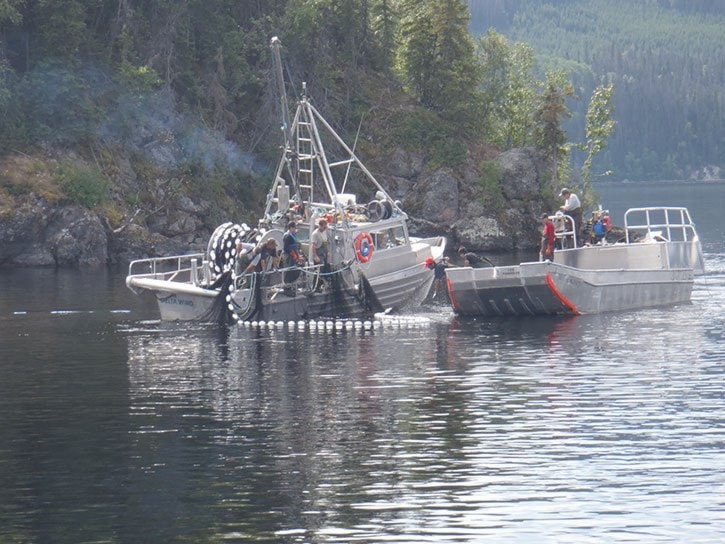A large predicted salmon return this year has Lake Babine Nation gearing up for their fishing season for the first time since 2012.
The Department of Fisheries and Oceans Canada (DFO), the lead agency for salmon management in B.C., have predicted a large return for a handful of the Fraser Rivers’ 44 sockeye salmon population.
Most of the sockeye salmon returning to the Fraser River this year are the progeny of those that spawned in 2010, which was the largest salmon return in 100 years.
“We are gearing up for harvesting salmon for commercial sales right now, along with fishing salmon for personal use,” Wilf Adam, Chief of Lake Babine Nation said.
Lake Babine Nation made an internal decision last year to not commercially harvest the salmon due to the low population.
In fact, members were asked to refrain from catching salmon they normally would to feed themselves because the salmon population was so low.
However this year, both fishermen and conservationists alike are optimistic that sockeye salmon populations will run in large numbers this year because fish from abundant populations will be migrating back to their home rivers. The only problem is that fish from abundant populations will also be running alongside fish from depleted populations, such as Cultus Lake sockeye and Sakinaw Lake sockeye.
Both of those sockeye populations are classified as endangered by the Committee on the Status of Endangered Wildlife in Canada.
However, the depleted salmon stock will have little effect on Lake Babine Nation’s harvest of salmon this year because the salmon outlook for Babine Lake is at the high end of the DFO 2014 salmon outlook.
“Well, the salmon stock has improved greatly from what it was last year. The previous years we have fished both for commercial and personal sale, and we will be doing that again this year,” Adam said.
The DFO has been testing the salmon run by sending out boats with nets to test the hypothetical catch in order to determine the expected salmon run for the year.
Area director for the North Coast for the DFO, Mel Kotyk advises that while it is still early, the outlook for 2014 looks good.
It is expected that approximately 2.4 million salmon will migrate through Babine Lake this season.
Projected forecasts done by the DFO are split into four outlook categories that reflects the interpretation of quantitative and qualitative information, including preseason statistics and opinions of the DFO Stock Assessment staff.
The categories from one to four, forecast the salmon population and indicate what restrictions have been place on the population.
Category one, which means the stock is of concern and is forecasted to be less than 25 per cent of the target or is declining rapidly, in which case directed fisheries are unlikely and a requirement to avoid indirect catch of the stock will be levied.
Category two, which means the stock is low, the population is well below target an allocation policy will determine harvesting opportunities.
Category three, means the population is near target and directed fisheries will be subject to allocation policy.
Finally, category four, means the population stock is abundant and well above target goals.
The four above outlook categories are assigned each season by the DFO to each outlook unit, meaning to each lake and river.
Of the 84 outlook units categorized, 22 improved in category, including Babine Lake and the Skeena River sockeye.
Babine Lake has been classified as category four by the DFO, and is expected to have an abundance of age four sockeye salmon, not surprising considering those sockeyes are spawns of the record 2010 run.
Last year, Babine Lake was classified as a category three to four.
What that all means for Lake Babine Nation is that they’ll be casting their nets into the water this year to harvest the salmon.
“Being able to commercially fish for salmon means a lot for Lake Babine Nation because we eat it [salmon], and it means dollars for Lake Babine, Tachet and the other outlining communities,” Adam said.
Among other uses, Lake Babine Nation smokes and sells salmon locally, as well as selling it to customers in Vancouver and on the coast.
“It is a substantial revenue source for Lake Babine Nation, not a primary revenue source but it’s a substantial one,” Adam said.
And that revenue that is brought in from harvesting salmon is vital to the people in the community, and to the development of projects within the community.
“Not being able to commercially harvest the salmon in previous years has impacted our community in a lot of ways, a lot of our citizens, especially the elders didn’t get their fish for the year, and that really is the main concern,” Adam said.
“Any projects that we had planned in place for communities had to be put on hold due to lack of revenue.”
The first run of salmon in Babine Lake is expected to take place in approximately two weeks, however the number of fish during that run will not be particularly abundant.
